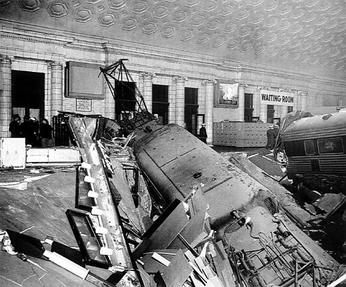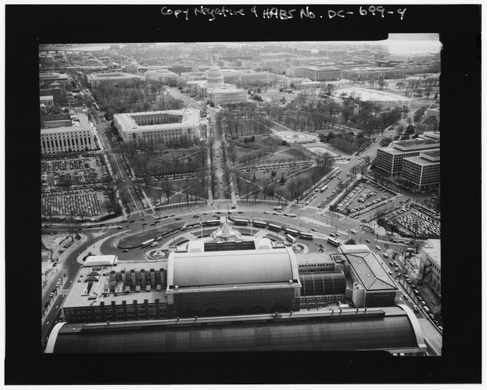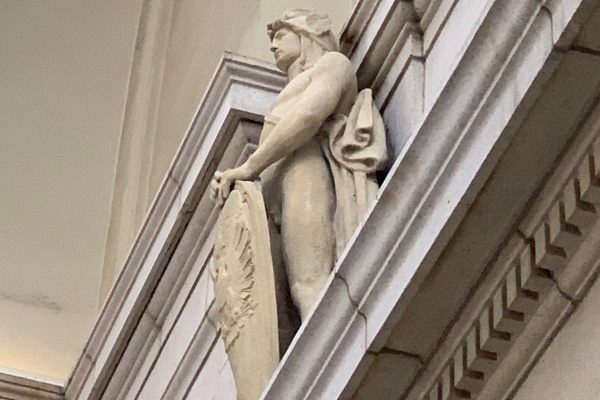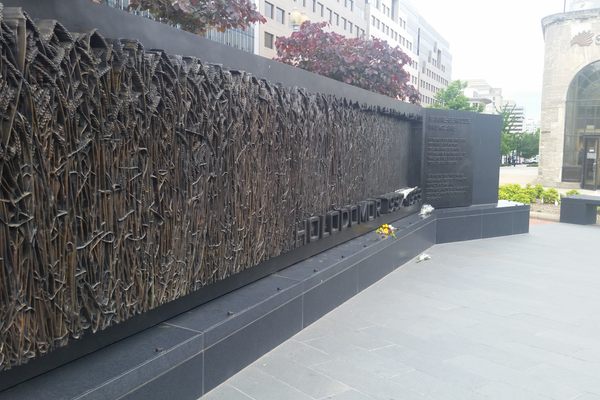Site of the Union Station Train Crash
A 1,100-ton train fell through the floor in 1953. Workers got it patched up in just 72 hours.
At 8:38 am on January 15th, 1953, a man ran out of Union Station onto the concourse screaming “run for your lives!” Twenty seconds later the building shook as a runaway 1,100-ton passenger train smashed through the north wall and collapsed through the floor into the basement. Dozens of passengers were injured but, amazingly, there were no fatalities on the train or in the station.
The Federal Express 173 Boston-Washington train consisted of an electric locomotive and 16 coach and Pullman sleeper cars. The crash was caused by a design flaw in the train’s airbrake system.
The first warning signs that a crash was on the way appeared about 15 minutes outside of Washington. The engineer started decelerating from the cruising speed of 80 mph, but the train wouldn’t go below 60 mph. The emergency braking system temporarily slowed the train down, but the declining slope of the tracks approaching Union Station all but canceled it out.
At the time, trains didn’t have two-way radios, so the only warning signal the engineer could give was with the train’s horn.
According to a Washington Post account, the conductor ran through the cars shouting for passengers to “lie down on the floor or lie down on your seat.” As the out-of-control train buzzed the K Tower in Union’s rail yard at 50 mph, it was obvious that a disaster was moments away.
The towerman frantically telephoned the station master “Runaway on Track 16!” and through their quick action, the platform was cleared. Luckily, unlike today’s Amtrak passengers, most people waited for their trains on now-removed benches in the main hall, so the concourse area was relatively empty.
The Post quotes from one of their own employees, a young layout artist who happened to be in one of the front three cars on his morning commute from Baltimore.
“There was a tremendous rumble and the screeching of steel rubbing against steel,” said 25 year old Edward K. Koch. “The end of the car was tossed upward. Sparks were flying all over the place… Smoke and cement dust billowed up and about the car and we couldn’t see out the windows… For a moment there was a period of awesome silence, punctuated by the sizzle of steam and the sputtering of live wires.”
Four-hundred station laborers got to work immediately repairing the damage—the Eisenhower inauguration was just five days away and Union Station was expecting large crowds. The locomotive was lowered down into the basement so it could be dismantled and brought above ground. The engine was later rebuilt, saw 30 years of continued service, and is currently at a railroad museum in Baltimore.
Steel supports were installed in the hole in the station floor, and according to the Post, it was bridged with “two-inch tongue-and-groove wood flooring supported by heavy timbers” within 72 hours. The temporary floor was solidified by “quick drying asphalt [that] was applied over the wood floor.”
Amazingly, the station was fully reopened within three days of the crash. The temporary floor was replaced with an all steel and concrete one later that summer.
Know Before You Go
Head to the Amtrak ticket counter and look towards the back of the station. This is the direct line of impact.
Community Contributors
Added by
Edited by
Plan Your Trip
The Atlas Obscura Podcast is Back!
























Follow us on Twitter to get the latest on the world's hidden wonders.
Like us on Facebook to get the latest on the world's hidden wonders.
Follow us on Twitter Like us on Facebook